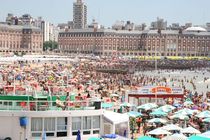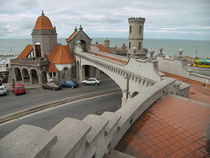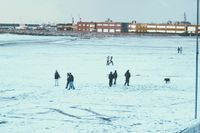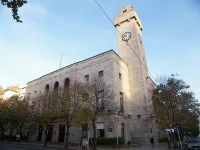Mar del Plata
| Mar del Plata | |
|---|---|
|
|
|
 Mar del Plata
|
|
| Coordinates: | |
| Country | |
| Province | |
| Partido | General Pueyrredón |
| Founded | February 10, 1874 |
| Government | |
| - Intendant | Gustavo Pulti |
| Area | |
| - Total | 79.48 km2 (30.7 sq mi) |
| Elevation | 38 m (125 ft) |
| Population (2001) | |
| - Total | 541,733 |
| - Density | 6,816/km2 (17,653.4/sq mi) |
| Postal code | B7600 |
| Phone code | +54 223 |
| Website | www.mardelplata.gov.ar (Spanish) |




Mar del Plata is an Argentine city located on the coast of the Atlantic Ocean in the Buenos Aires Province, 400 km (249 mi) south of Buenos Aires. The name "Mar del Plata" had apparently the sense of "sea of the Río de la Plata region" or "adjoining sea to the Río de la Plata".[1] Mar del Plata is one of the major fishing ports and the biggest seaside beach resort in Argentina. With a population of 541,733 as per the 2001 census [INDEC], it is the 7th largest city in Argentina.
Contents |
Economy
As part of the Argentine recreational coast, tourism is Mar del Plata's main economic activity with seven million tourists visiting the city in 2006. Mar del Plata has a sophisticated tourist infrastructure with countless hotels, restaurants, casinos, theatres and other tourist attractions. Mar del Plata is also an important sports centre with a multi-purpose Olympic style stadium (first used for the 1978 World Cup and later upgraded for the 1995 Pan American Games), 5 golf courses and many other facilities.
As an important fishing port, industry concentrates on fish processing and at least two large shipyards.[2]
The area is also host to other light industry, such as textile, food manufacturing and polymers. There is a well-developed packaging machines industry, its quality being recognized in international markets[3]. One of these companies was one of the pioneers in the automatic packaging of tea bags[4], exporting its original machine-designs abroad. Another company also exports its products and sold royalties to other countries.[5]
During the mid 1980s, Mar del Plata saw the birth of electronics factories, focused mostly on the telecommunications field, with two of them succeeding in the international market.[6]
Located southwest of the city there are quartzite quarries. The stone is traditionally used in construction (see Architecture). There is a huge area of farms in the rural areas surrounding the city, specialized mostly in the cultivation of vegetables.
Although the area had suffered from a high rate of unemployment from 1995 to 2003, Mar del Plata has seen 46,000 new jobs created from the third quarter of 2003 to the third quarter of 2008, representing an increase of 22%.[7] The 2008 Davis Cup Final was held in Mar del Plata and, after being shut for a decade the Gran Hotel Provincial (one of the largest hotels in Argentina) was reopened by the Madrid-based NH Hotels, in 2009.
Mar del Plata continues to lead Argentina's room availability: of 440,000 registered hotel rooms nationwide in early 2009, the city was home to nearly 56,000 (5,000 more than Buenos Aires).[8]
Transportation
Mar del Plata is served by Ástor Piazzola International Airport (MDQ/SAZM) with daily flights to Buenos Aires served by Aerolíneas Argentinas and Sol Líneas Aéreas and weekly flights to Patagonia served by LADE.
It has a bus terminal serving most cities in Argentina. There is a train station with two daily trains to Buenos Aires' Estación Constitución.
Highway 2 connects Mar del Plata with Buenos Aires and Route 11 connects it through the coastline, ending at Miramar, 40 km (25 mi) south of Mar del Plata. Route 88 connects to Necochea) and Route 226 to Balcarce, Tandil and Olavarría.
History
Pre-Spanish era: The region was inhabited by Günuna Kena nomads (also known as northern Tehuelches). They were later (after the 11th century) strongly influenced by the Mapuche culture.
1577-1857: First European explorers. Sir Francis Drake made a reconnaissance of the coast and its sea lion colonies; Don Juan de Garay explored the area by land a few years later. In 1742, during the War of Jenkin's Ear, eight survivors of HMS Wager, part of Admiral Anson expedition, and led by Isaac Morris, lived through a ten-months ordeal before being decimated and captured by the Tehuelches, who eventually handed them to the Spaniards. After holding the Englishmen as prisoners, they returned Morris and his companions to London in 1746.[9] First colonization attempt by Jesuit Order near Laguna de los Padres ended in disaster (1751).
1857-1874: The Portuguese entrepreneur Coelho de Meirelles, taking advantage of the country’s abundance of wild cattle, built a pier and a factory for salted meat, but the business only lasts a few years.
1874-1886: Patricio Peralta Ramos acquired the now abandoned factory along with the surrounding terrain, and founded the town on February 10, 1874. Basque rancher Pedro Luro bought a part of Peralta Ramos land for agricultural production. First docks also erected around this time.
1886-1911: The railway line from Buenos Aires, built by the Buenos Aires Great Southern reached Mar del Plata in 1886; the first hotels started their activity. The upper-class people from Buenos Aires became the first tourist of the new born village. They also established a local government that reflected their conservative ideals. Build-up of a French style resort.
1911-1930: The residents, mostly new arrived immigrants from Europe, demanded and obtained the control of the Municipality administration. The socialist were the mainstream political force in this period, carrying out social reforms and public investment. The main port was also built and inaugurated in 1916.
1930-1946: A military coup reinstated the Conservative hegemony in politics through electoral fraud and corruption, but in the local level they were quite progressive, their policies viewed in some way as a continuity of the socialist trend. The seaside Casino complex opened in 1939, was designed by architect Alejandro Bustillo, and Highway 2, the main road to Buenos Aires, also dates from this period.
1946-1955: Birth of the Peronist movement. A coalition between socialists and radicals defeated this new party by a narrow margin in Mar del Plata, but by 1948 the Peronism will dominate the local administration. The massive tourism, triggered by the welfare politics of Perón and the surge of the middle class marked a huge growth in the city’s economy.
1955-1970: After the fall of Perón, the socialists regained the upper hand in local politics; the city reached the peak in activities like construction business and building industry. Massive immigration from other regions of Argentina.
1970-1989: Slight decline of tourism demand, counterbalanced by the increasing of other industries such as fishing and machinery. General infrastructure renewal under the military rule. The centrist Radical Civic Union becomes the main political force after the return of Democracy in 1983.
1989-Present: Though the Peronism replaced the radicals in central government amid a national financial crisis, the latter party continued to rule in Mar del Plata. Some resurge of mass tourism in the early '90s was followed by a deep social crisis in town, with an increase of poverty, jobless rate and emigration. By contrast, the first decade of the 21st century shows an amazingly quick recovery in all sectors of the ailing economy.
On November 2005 the city hosted the 4th Summit of the Americas.
Culture


Mar del Plata is the most popular destination for conventions in Argentina after Buenos Aires. Mar del Plata has a wide range of services in this sector. The summer season hosts over fifty theatrical plays.
These are the most important shows and festivals:
- The Fiesta Nacional del Mar ("National Sea Festival") with the election and coronation of the Sea Queen and her princesses, which takes place in December as the official inauguration of the summer season.
- The Premios Estrella de Mar ("Sea Star Awards") which honor the best stage plays and shows of the season.
- The Valencian Falles week, a local reenactment of the Valencian event conducted by the Valencian community.
- The Mar del Plata Fashion Show, along with a number of fashion parades that gathers the best haute couture designers.
- The Fiesta Nacional de los Pescadores (National Fishermen's Festival), a colourful display of seamen tradition and cuisine.
- The Mar del Plata International Film Festival, the only competitive accredited film festival in Latin America.
- Mar del Plata has also hosted the 1995 Pan American Games, the 2003 Parapan American Games, the 2005 FIBA Under-21 World Championship, and co-hosted the 1978 FIFA World Cup and the 2001 FIFA World Youth Championship.
- Since 1987 Mar del Plata annually hosts the Mar del Plata Marathon, in early December.
The local Government sponsors a stable Symphonic Orchestra, as well as a Conservatorium and a School of Classical and Modern Dance.

The main museums are the following:
- The Juan Carlos Castagnino Municipal Museum of Art.
- The Museum of the Port of Mar del Plata Cleto Ciocchini.
- The Museum of Natural Science Lorenzo Scaglia, specialized in Paleontology of the Quaternary species around the region.
- The Mar del Plata Museum of the Sea, which includes one of the most complete collections of sea snails of the World.
- Villa Victoria, a vintage wooden house, the former residence of the late writer Victoria Ocampo, now a place for art expositions and classical music.
Culture and Sports Personalities:

- Alberto Bruzzone (1907-1994), painter, was born in San Juan but chose Mar del Plata as his home city.
- Astor Piazzolla, composer and musician.
- Auro Tiribelli (1908-2006), architect, the main representative of the Mar del Plata style.[10]
- Erica Bibbó (1985), the first female commander of a naval unit in the Argentine navy.[11]
- Gabriel Gaby Amato, former international soccer player.
- Germán Mono Burgos, former goalkeeper. He played two World Cups. Currently, he is oriented to music.
- Guillermo Vilas, top tennis star in the 1970s.
- Héctor Babenco, movie director, who made Hollywood films like Kiss of the Spider Woman and Ironweed.
- Homero Cárpena (1910-2001), actor, playwright and filmmaker.
- Inés Arrondo, hockey player, winner along with the national team of an Olympic Silver medal in Sydney 2000 and a Bronze medal in Athens 2004.
- Juan Carlos Castagnino, painter.
- Juan Eduardo Esnáider, international soccer player. Former forward of Espanyol, Atlético de Madrid, Juventus, River Plate.
- Jorge Lanata, journalist and writer.
- Laura Echarte, agricultural engineer, researcher in crop physiology studies, winner of a 2007 L'Oreal-Unesco international fellowship for Women.[12]
- Maria Gabriela Palomo, marine biologist, also winner of the L'Oreal-Unesco junior award in 2003 for her works on port-areas environmental pollution.[13]
- Mario Benedetti (1945), electronics engineer, the main Argentine scientist involved in the Large Hadron Collider project. He is also the owner of Tío Curzio, one of the most fashionable restaurants in the city.[14][15][16]
- Martin Donovan (not to be confused with American actor Martin Donovan), Hollywood screenwriter and producer, co-author of the screenplay of movies like Death Becomes Her and Loving Couples.
- Nacha Guevara, singer and actress.
- Ricardo Piglia, writer born in Adrogué but raised in Mar del Plata.[17]
The common linguistic and social background of the city is that of the so called rioplatense culture.
Architecture

.jpg)
The development of the city as a seasonal resort in the early 20th century led upper class tourists from Buenos Aires to build a European-inspired architecture, based mainly on the picturesque and later on the art deco styles. This gave Mar del Plata the nickname of the Argentine Biarritz. The building industry became the main non-seasonal activity of the town by 1920.
During the '30s,'40s, and beyond, local architects and builders, like Auro Tiribelli, Arturo Lemmi, Alberto Córsico-Picollini and Raúl Camusso recreated and transformed the picturesque values into a middle-class scale, marking the beginning of the so called Mar del Plata Style, consisting in small samples of the luxury-laden summer residences of high society, built for the summer visitor as well as for the local resident.
These chalets were built with stone façades, gables roofs covered with Spanish or French tiles, prominent eaves and front porches. This gives the town some distinctive urban character compared with other Argentine cities, despite the fact that the growing mass of tourists in the '60s imposed the construction of large apartment buildings and skyscrapers as the predominant architectural style downtown.[18]
Climate
The weather pattern for the region is that of an oceanic climate, with humid and moderate summers and relatively cool winters, although polar air masses from Antarctica are frequent. The average temperatures for January reach 20°C (68 Fahrenheit) and 8°C for July (46 Fahrenheit). The West-Southwest winds bring down the temperature below 0°C (32 Fahrenheit), while the Southeast ones (the so called Sudestada) are stronger, producing coastal showers and rough seas, as well as strong squalls, but the cold is much less intense.[19]


There are about 20 days of frost each year, and almost 60 in the west hills area (some 300 mts above the sea level). Snowfall is not uncommon, but snow accumulation on the ground is rare, a phenomenon that takes place every 6 years or so, according to the last 40 year's data.
Among the most best known such occurrences were the 1975 and 1991 snowstorms, but there were also snow accumulations in 1994 and 1997, in the highest hills area of Sierra de los Padres, in 1995 along the southern coast, and other two during the first hours of July 10, 2004 and July 15, 2010.[20] There were two low-intensity snowfalls in September 1986 and June 2007.[21] There is fog in the last days of fall, and springtime is often marred by sea winds and sudden temperature's changes. There are some ten days of 30°C (86 Fahrenheit) each summer, certainly milder values than the rest of the pampas region. Usually, the summer nights are cool and pleasant, with values between 13º to 17°C (55 to 63 Fahrenheit). The record high is 41º on January 1957 (105 Fahrenheit). The wet season occurs during spring and summer, specially in January, with values between the 70 and 80 mm. The average annual rainfall is 780 mm.[19]
Government


Mar del Plata is the head of the department (Partido) of General Pueyrredón. The current Mayor of the city and department is Gustavo Pulti, of the local party Acción Marplatense.
The Honorable Concejo Deliberante (the town council) has some legislative powers. The term of office for both the Mayor and council members is four years.
In 1919, Mar del Plata became the first town in South America to have a Socialist Mayor, a son of Italian Immigrants, Teodoro Bronzini. The Socialist Party would dominate the city political landscape for most of the 20th century.
The Government official page has a comprehensive listing of all Mayors and Commissioners of Mar del Plata from 1881 to the present.
There is an extensive but interesting work by the American sociologist Susan Stokes about the democratic process in Mar del Plata since 1983 in comparison to other regions of Argentina.[22][23] One of the main thesis of her articles is that the social and economic development of Mar del Plata was quite atypical, with a strong prevalence of middle-class values that discouraged the policy of clientelism that is the common background in other urban environments of Argentina.[24]
Sister cities
 Biarritz, France
Biarritz, France Fort Lauderdale, USA
Fort Lauderdale, USA San Benedetto del Tronto, Italy
San Benedetto del Tronto, Italy Bari, Italy
Bari, Italy Saint Petersburg, Russia
Saint Petersburg, Russia
References
- ↑ Creemos, sin embargo, que por ser el primer contacto que los hombres del Río de la Plata tomaron con el mar se llamó a este punto precisamente mar "del Plata". Cova, Roberto Osvaldo: Síntesis histórica de Mar del Plata: notas para el conocimiento del origen, evolución y desarrollo de la ciudad y de la zona. 1969, p. 8 (Spanish)
- ↑ Links:
- ↑ TECMAR
- ↑ Mai S.A
- ↑ Orengia y Conforti Ind. y Com. S.A
- ↑ Links:
- ↑ INDEC
- ↑ Argentina Municipal: La ciudad de Mar del Plata lidera la oferta hotelera del país (Spanish)
- ↑ Historical Materials from Southern Patagonia
- ↑ Murió el arquitecto Auro Tiribelli, creador del chalet marplatense (Spanish)
- ↑ La Capital newspaper, 5 July 2009 (Spanish)
- ↑ Argentine scientist gets L'Oreal-UNESCO award
- ↑ Prize-Giving Ceremony for 2003 L’ORÉAL-UNESCO 'Women in science' Awards
- ↑ Aplicaciones biológicas de la investigación en física de altas energías (Spanish)
- ↑ Visita a la “máquina de Dios” Página 12 newspaper, 16 June 2009 (Spanish)
- ↑ CERN document server: "Three Presidents in one day"
- ↑ Private eyes & time travelers
- ↑ Cacopardo, Chapter VII (by Javier Sáez)
- ↑ 19.0 19.1 Roccatagliata, pp. 167-174
- ↑ Una ola de frío invade a todo el país La Nación, 15 July 2010 (Spanish)
- ↑ Retrieved from the following editions of La Capital newspaper:
- 17 July 1975
- 17 September 1986
- 2 August 1991
- 5 August 1995
- 27 June 1997
- 11 July 2004
- 26 June 2007
- ↑ Helmke and Levitsky, Chapter 6
- ↑ PDF-2
- ↑ Shapiro and Bedi, pp. 191-195
Further reading
- Cacopardo, Fernando A. & others: Mar del Plata, Ciudad e Historia. Alianza Editorial S.A./UNMDP, Madrid/Buenos Aires, 1997. ISBN 9504001556. (Spanish)
- Rocatagliata, Juan A. & others: Mar del Plata y su Región. Sociedad Argentina de Estudios Geográficos, Buenos Aires, 1984. (Spanish)
- Anniversary Editions of La Capital newspaper: 1955, 1980, 1985, 2005. (Spanish)
- Barili, Roberto T.: Mar del Plata, Reseña Histórica. Published by the Municipality of Gral. Pueyrredón, Mar del Plata, 1964. (Spanish)
- Zago, Manrique: Mar del Plata, Argentina. Manrique Zago Ed., 1997. (Bilingual Edition)
- Stokes, Susan C.:Do Informal Institutions Make Democracy Work? Accounting for Accountability in Argentina. University of Chicago. Prepared for presentation at the conference, “Informal Institutions in Latin America”. University of Notre Dame, April 23-24, 2003.
- Shapiro, Ian and Bedi, Sonu : Political Contingency: Studying the Unexpected, the Accidental, and the Unforeseen. New York University Press, 2007. ISBN 0814740448
- Helmke, Gretchen and Levitsky, Steven: Informal Institutions and Democracy:Lessons from Latin America. John Hopkins University Press, 2006. ISBN 0801883512
External links
- Official Government website (Spanish)
- National University of Mar del Plata (Spanish)
- Mar del Plata holiday and investments (English)
- Website of Mar del Plata
- Mar del Plata Guide. hotel information, culinary and shopping
- Tandilfullchat Gente zona de Mar del Plata.
- How to reach Mar del Plata? find the best road, maps and distances from other argentinian cities?
- Mar del Plata travel guide from Wikitravel
- Accommodation Guide and Tourist Information in English(English)
|
|||||||||||||||||
|
|||||